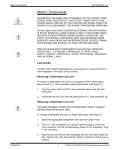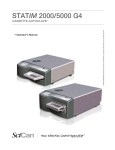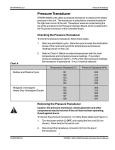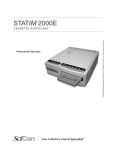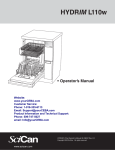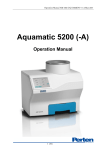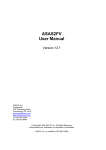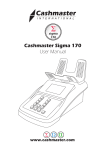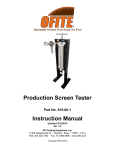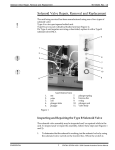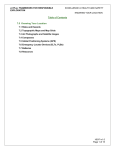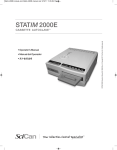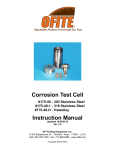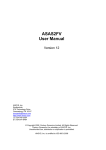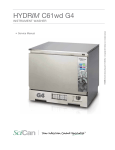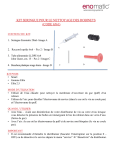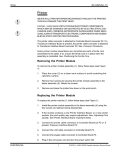Download STATflow operator manual
Transcript
STATFlow Direct-to-Drain System ™ For use with STATIM® 2000 and STATIM 5000 Autoclaves STATFlow Installation Guide and Operator’s Manual 95-113193 Rev 2.0. Copyright 2012 SciCan Ltd. All rights reserved. • Installation Guide and Operator’s Manual Table of Contents 1. Introduction ................................................................................................................. 1 2. Important Information ................................................................................................. 1 3. Installation Overview ................................................................................................... 2 4. Preparation .................................................................................................................. 4 5. Plumbing Modifications .............................................................................................. 5 6. Cabinetry Modifications .............................................................................................. 6 7. Connecting Tubing ...................................................................................................... 8 8. Getting Started .......................................................................................................... 10 9. Maintenance .............................................................................................................. 11 10. Troubleshooting ....................................................................................................... 11 Specifications STATFlow Direct-to Drain System Tank material Polyethylene regrind Tank dimensions 19.3 cm x 19.3 cm x 27.3 cm (7.6 in x 7.6 in x 10.75 in) Tank volume 5.7 L (1.5 gallon) Tank weight with water 6.8 kg (15 lbs) Cold water connectionConnection for 1/4” OD tubing required (not supplied, to be done by plumber) Inlet water pressure 1 - 7 bar (14.5-101.5 psi) Ambient operating temperature and humidity 5°C - 40°C (41°F - 104°F); 80% max. humidity Max. altitude 2000 m For additional information: Manufactured by: SciCan Ltd. 1440 Don Mills Road, Toronto, ON M3B 3P9 CANADA Phone: (416) 445-1600 Fax: (416) 445-2727 Toll free: 1-800-870-7777 SciCan, Inc. 701 Technology Drive Canonsburg, PA15317 USA Phone: (724) 820-1600 Fax: (724) 820-1479 Toll Free: (800) 572-121 U.S. service information United States: 1-800-572-1211 Email: [email protected] Canada: [email protected] USA: [email protected] STATIM is a registered trademark and STATFlow and “Your Infection Control Specialist” are trademarks of SciCan Ltd. STATFlow is manufactured by SciCan Ltd. under license from Vista Research Group, LLC. Patent pending. SciCan STATFlow 1. Introduction About the STATFlow Direct-to-Drain System The STATFlow Direct-to-Drain system replaces the need for a STATIM condenser/waste bottle by cooling the exhaust water from STATIM 2000 and STATIM 5000 autoclaves and automatically sending it directly down the drain. About this Installation Guide and User Manual This manual was created as a reference for the installation of the STATFlow Direct-to-Drain System and to provide information to users concerning the care and operation of the system. If you have a question about the unit you are installing, please contact your local SciCan representative. Any installation of the STATFlow must observe the plumbing code criteria as specified by the municipality or region governing the installation site. Recommendation: kit to be installed by a service professional. 2. Important information Warnings and Precautions The details of installing and operating your STATFlow system are all contained within this manual. Installation and maintenance instructions should be followed for the system to perform as designed. The STATFlow system is designed specifically to function with STATIM 2000/5000 and STATIM G4 2000/5000 (available in Canada only). It is not designed for use with other models or products. Using it with other models or products may result in damage to equipment or plumbing infrastructure. Do not permit any person other than certified personnel to supply parts for, service, install or maintain your STATFlow system. SciCan will not be liable for incidental, special or consequential damages caused by any maintenance or services performed on the STATFlow system by a third party, or for the use of equipment or parts manufactured by a third party, including lost profits, any commercial loss, economic loss, or loss arising from personal injury. Ensure correct water tank height As a non-pressurized system, the STATFlow must be installed so that the top of water tank is below the lowest point on the air gap assembly and above the connection to drain. Typically this will require elevating the water tank. If a STATFlow system is installed without respecting these relative heights, it may not function properly. Perform tests When the installation is complete, turn on the water supply and check for leaks. If there are no leaks, run three consecutive cycles with the STATIM. Check for leaks and watch the tubing to ensure water is draining correctly. Page 1 3. Installation overview Side view STATIM F YEL O RED N M FLOW 200 RED H RED BLU J Q P C BLU B D L BLU G K A Hot Cold Page 2 GRN E 3. Installation overview F Top view STATIM O N YEL GRN J BLU BLU G K M P Q C D BLU W FLO 200 L RED B E A RED COLD WATER H RED Page 3 4. Preparation Remove contents from the box. Check to see that all parts are present and undamaged. Box includes: (G) Drain adapter tee FLOW 200 (A) Tank with manifold/coil assembly (GRN) Length of 3/8” clear tubing (green tie wrap) (M) Flow rate regulator (F) Air gap assembly (J) Thermal sensor assembly (H) Water supply valve (YEL) 1/4” Teflon tubing (yellow tie wrap) NOTE: similar to (BLU) – do not confuse (RED) 1/4” polyurethane tubing (red tie wrap) (BLU) 1/4” LLDPE tubing (blue tie wrap) NOTE: tubing has printed text on outer wall NOTE: Connection needed to tap into the cold water supply is not included (see Section ‘Plumbing. Install the drain adapter tee assembly’), installer must provide a fitting for receiving the 1/4” O.D. tubing at installation. Page 4 RED 5. Plumbing Install the drain adapter tee assembly. RED RED 1. Tap the cold water supply line and connect a 3” to 4” section of ¼” clear tubing (RED) to the water supply valve (H). 2. Attach water supply valve (H) by pushing the clear ¼” tubing (RED) into the pressure fitting. Be certain the valve is in the closed position with the blue lever at 90-degrees to the valve. RED NOTE: Connection needed to tap into cold water supply is not included. Installer must provide a fitting for receiving the ¼” OD tubing at installation. G 1” minimum Hot H Cold Page 5 3. Measure the drain adapter tee assembly for placement on the drain assembly. Cut and remove a section of the drain assembly above the P-trap. Install the drain adapter tee (G) as low as possible, while maintaining a minimum 1” offset from the drain. 6. Cabinetry Install the air gap assembly. OR 1-1/4” 1. The air gap assembly (F) is designed to fit into the sprayer hole of standard sinks. If this option is not available, drill a 1-1/4” diameter hole in the lip of the sink. If the sink is an under mount style, drill the hole as close to the edge as possible. It is important that water from the air gap assembly drain into the sink. 8 2. On the air gap assembly (F), pull upwards on the chrome cover to remove the top. Then remove the top threaded nut and washer, leaving the lower threaded nut in place. • Insert the air gap assembly (F) into hole from under the counter. • Place the washer followed by the top threaded nut at top of threads and turn only 2 to 3 times (just enough to catch a few threads). Then tighten the air gap assembly from OR underneath the counter using the bottom threaded nut. F 4 3. Replace the chrome cover making sure the opening does not reveal the overflow outlet. OR Page 6 F 6. Cabinetry 4. Route the ¼” Teflon exhaust tubing from the STATIM to the STATFlow system. • Drill ½” holes in the cabinetry between the STATIM and the STATFlow system. Use ¼” Teflon tubing (YEL) supplied with the STATFlow. Be certain the ¼” Teflon tubing runs down from the STATIM to the STATFlow system. The entry hole into the cabinet housing the STATFlow tank should be higher than the top of the tank (see section ‘Starting and using the STATFlow system’ for tank placement). When possible, tubing should not have any level sections where water draining from the STATIM can collect. Avoid areas where the ¼” Teflon tubing can be pinched by drawers. 1/2” STAT IM STATFlow YEL NOTE: extra long (16ft / 4.9m) tubing available as spare part (ol-1134685) Page 7 7. Connecting tubing IMPORTANT INFORMATION • All tubing cuts must be even and clean. • All fittings are a push-to-connect design, except the barbs on the brass water valve. • Use a twisting motion when pushing tubing into fitting to ensure ends are fully inserted. • Do NOT use any lubricants other than clean water. Moisten the tubing ends with water before inserting into fittings if lubrication is needed. • Cut tubing to allow sufficient length so that no tubing line is tight or stressed and so that tank assembly can be moved within the cabinet. • Tubing connecting to drain should be as short as possible and must not droop, loop or sag in a way that would form a trap that can cause flow resistance. • Ensure that flow is not impeded by kinked or bent tubes. 1. Fill the water tank. C • Remove the manifold and coil assembly (C) from the water tank (A). • Fill tank completely. Place the full water tank under the sink. A Page 8 7. Connecting tubing F STATIM O N YEL GRN J BLU BLU G K M P BLU Q C D W FLO 200 L RED B E A RED COLD WATER H RED 2. Connect the water supply to the water tank. Using ¼” clear tubing (RED), connect one end to the water coolant valve (H) by pushing tubing into the push-to-connect fitting and the other end to the top of the fitting on the brass valve (B) of the water tank (warm the tubing with hot water and make sure the tubing is pushed down so that it is flush with the top of the steel hex nut). 3. Connect the air gap to the water tank. • Using a section of ¼” clear tubing (RED), push one end into the smaller ¼” leg (N) of air gap assembly (F) and the other end into the flow rate regulator (M). The arrow on the flow rate regulator should be pointing towards the air gap assembly. • Cut another section of ¼” clear tubing (RED). Push one end into the flow rate regulator and the other end onto the side fitting on the brass valve (B) of the water tank (warm the tubing with hot water and make sure the tubing is pushed all the way onto the fitting). • Using the larger diameter 3/8” clear tubing (GRN), connect the 3/8” inlet fitting on the large leg (O) of the air gap assembly (F) to the coolant inlet fitting (E) on the water tank. 4. Connect the STATIM exhaust to the manifold. Connect the ¼” Teflon tubing (YEL) from the STATIM exhaust to the white Kynar inlet fitting (P) on the top of the manifold. Be sure that this tube does not kink when installed or when moving the STATIM. 5. Connect the manifold to the drain. Remove the tubing loop on the drain adapter tee (G) and connect a section of ¼” LLDPE tubing (BLU) from the outlet fitting (Q) on the manifold to the upper input (L) on the drain adapter tee. Cut this ¼” LLDPE tubing (BLU) and insert the in-line thermal sensor (J) oriented with the arrow pointing towards the drain and the black gasket closest to the drain. 6. Connect the water tank overflow port to the drain. Use ¼” LLDPE tubing (BLU) and connect the overflow port (D) on the water tank (A) to the lower input (K) on the drain adapter tee. Page 9 8. Getting started IMPORTANT INFORMATION Ensure correct water tank height As a non-pressurized system, the STATFlow must be installed so that the top of water tank is below the lowest point on the air gap assembly and above the connection to the drain. Typically this will require elevating the water tank. A STATFlow system installed without respecting these relative heights may not function properly. Starting and using the STATFlow system 1. Turn on the water supply and check for leaks. 2. Slowly open the water supply valve (H) to the STATFlow system and check for leaks. 3. Prime the system by inserting a small screwdriver in the hole at the base of the water tank’s brass valve (B) and pushing up on the poppet valve. The system is primed when water can be seen leaving the overflow valve through the tubing to the drain adapter tee. 4. Set the water tank in an elevated position above the drain connections on the P-trap to ensure proper drainage. The correct height will vary with each installation. What is most important is to ensure the top of the water tank is LOWER than the air gap assembly legs and ABOVE the drain points in the drain adapter tee. B 5. When the installation is complete, turn on the water supply and check for leaks. If there are no leaks, run 3 consecutive cycles with the STATIM. Check for leaks and watch tubing to ensure that the water is draining correctly. 6. Use the STATFlow system. Since the STATFlow system is designed as a low-maintenance, automatic alternative to using condenser/waste bottles, once it is properly primed it will function without operator input. Beyond periodic visual inspections of the tubing, there is nothing an operator must do to ensure continued and safe operation. Page 10 9. Maintenance The STATFlow Direct-to-Drain system is designed to require minimum maintenance. However, it is recommended that operators periodically verify that the tubing and connections are free of mineral deposits and not compromised in any way. The system includes several failsafe devices designed to stop the flow of exhaust water from the STATIM in the event of a problem. Operator Every 6 monthsCheck clear tubing for mineral deposits. Visually inspect all connections to ensure there are no leaks. Technician Once a year Visually inspect system checking for leaks. 10. Troubleshooting ProblemCause/solution System is not draining • Ensure water supply valve is in ON position. • Check for blockages in tubing. • Check water level in tank. STATIM is displaying cycle fault 10 or 11 • Exhaust port is blocked. Check for kinks in tubing from Statim to STATFlow system (drawers pinching line, etc…) • Check that water is draining. Water is coming out of air gap assembly / there is water on the counter • Ensure sink is not plugged. • Raise water tank so that top of tank is above the drain point and below the air gap as described in Chapter 8: Getting Started. Water tank is bloated • Raise water tank so that top of tank is above the drain point and below the air gap as described in Chapter 8: Getting Started. Check the connections on the barb – ensure that water supply is attached to the top barb and the flowrate regulator/air gap is attached to the side barb. Water leaking under counter • Check all tubing connections. • Push in all connections to ensure tubing is solidly engaged. Page 11 APPENDIX Backflow Prevention Overview Airflow STATFlow employs an air gap that is a totally non-mechanical means of backflow prevention. The air gap is a physical separation between the potable water supply line and the non-pressurized condensing tank. In the event of backflow from the STATFlow tank, the potentially contaminated water would be expelled through the drain hole and discharged into the sink (see Section Cabinetry for air gap installation requirements). If there were suction from the potable water supply line, air would be pulled into the city source since the opening of the supply line is above the drain hole. The air gap has been certified by the International Association of Plumbing and Mechanical Officials (IAPMO) as compliant with the product’s performance standard and the Uniform Plumbing Code (UPC). Please refer to your local regulations for location specific requirements. Backflow SciCan STATFlow Appendix














